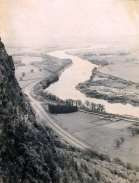GEOTECHNICS & THE VALLEY SECTION
Geddes was not a geographer in the strict sense of the word, but his interest in Regional Survey drew him into studies which clearly fall within the area of geography and his approach parallels the direction in which modern geography has developed. Regionalism was his main concern here and in the Valley Section, “the general slope from mountain to sea which we find everywhere in the world” he explored the dynamic relationship of society and environment through work. From this viewpoint, Geddes was critical of the passive role adopted by professional geographers, preferring the term “Geotechnics” to describe his own approach in which the practical application of knowledge was placed at the forefront. He claimed that the physical features of the world were well known while resources like the soils, forests and fisheries remained uncharted. “In a word we have many atlases of geography, but as yet no atlas of Geotechnics. Yet what would be more useful to each city and region? to each nation and empire? to the world as a whole?” But perhaps the most striking indication of his unified approach can be found in the lectures where geographical knowledge was used as a key to the history of ideas. Globes and maps of different periods were seen to reveal the history of man’s awareness of the world which was reflected in all other pursuits. “Acceptance of the Ptolemaic system involved a world view, the same with Copernicus. Especially in the golden moment of the Renaissance, education, theology, geography and philosophy are all interrelated”.
THE VALLEY SECTION

The Valley Section was originally placed in the Outlook Tower. In its original form it was the first well-known example of a geographical model – a simplification of reality which helps us to understand the real world and stimulates our thinking about it.

Geddes was greatly influenced by the ideas of LePlay on ‘Place, Work, Folk’ and the relationships between them. There were many local examples that fitted the model – lead mining at Leadhills and Wanlockhead, the forests of the Border hills, sheep farms on the Pentlands, farming in East Lothian and market gardening around Musselburgh. All contributed to the life of the town which served them in its turn. For the Outlook Tower the cold diagram was turned into a warmer and less formal illustration which retained the essentials. The three Ss – Sympathy, Synthesis and Synergy – are there as well, to remind us how to change things for the better. Under the Valley Section are descriptive comments – Microcosm of Nature, Theatre of History, Seat of Man, Future Utopia – reflecting Geddes’ optimistic view of the world.
